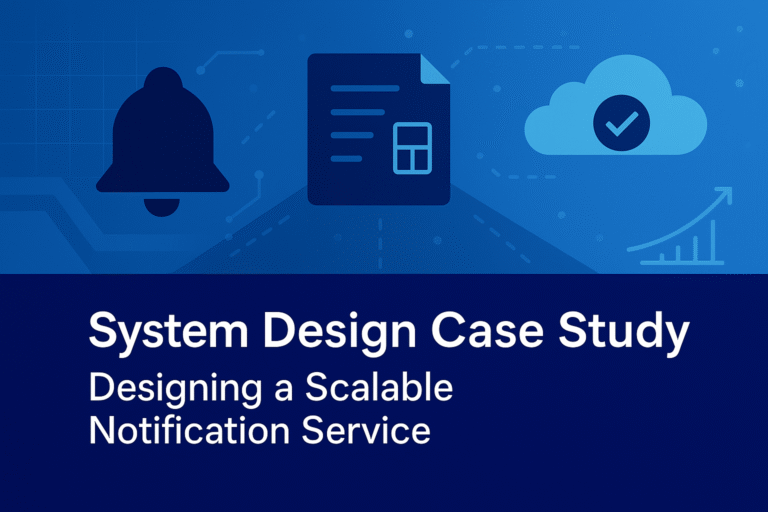Introduction
System design is a cornerstone of modern software engineering, encompassing the art and science of architecting scalable, reliable, and efficient systems to solve complex problems. In the context of technical interviews, particularly for software architect or senior engineering roles, system design questions evaluate a candidate’s ability to translate requirements into robust architectures. These questions test not only technical knowledge but also problem-solving skills, trade-off analysis, and the ability to communicate complex ideas clearly. With over two decades of experience in designing and troubleshooting distributed systems, I have witnessed firsthand the critical role system design plays in building resilient applications—and its equal importance in securing top-tier engineering positions. This article explores what system design entails, why it is a pivotal component of technical interviews, and how candidates can prepare effectively to excel in this domain.
What is System Design?
System design is the process of defining the architecture, components, interfaces, and data flows of a software system to meet specific functional and non-functional requirements. It involves making high-level decisions about how different parts of a system—such as databases, application servers, caches, load balancers, and message queues—interact to achieve goals like scalability, reliability, and performance. Unlike low-level design, which focuses on detailed implementation (e.g., class structures or algorithms), system design takes a holistic view, addressing how components integrate to form a cohesive, efficient system.
At its core, system design is about solving problems under constraints. For example, designing a notification service for millions of users requires balancing latency, cost, and reliability while handling unpredictable traffic spikes. My experience debugging production outages in high-traffic systems taught me that effective system design anticipates failure modes, optimizes resource usage, and prioritizes user experience. These principles are precisely what interviewers seek when evaluating candidates.
System design problems typically fall into two categories:
- Designing a System from Scratch: Candidates are asked to architect a system like a URL shortener, a social media news feed, or a ride-sharing platform (e.g., Uber). These problems test the ability to break down requirements, propose components, and justify design choices.
- Scaling or Optimizing an Existing System: Candidates must enhance an existing architecture to handle increased load, reduce latency, or improve fault tolerance. This tests adaptability and an understanding of trade-offs.
In both cases, system design requires synthesizing knowledge from databases, networking, distributed systems, caching, and more, making it a multidisciplinary challenge.
Why System Design Matters in Interviews
System design interviews are a critical component of the hiring process for architect-level roles at leading technology companies. Unlike coding interviews, which focus on algorithmic problem-solving, system design interviews assess a candidate’s ability to think strategically, make informed trade-offs, and communicate complex architectures. Below are the key reasons why system design is a focal point in interviews and why it matters for aspiring architects.
1. Evaluating Architectural Problem-Solving Skills
System design questions reveal how candidates approach ambiguous, open-ended problems. In real-world scenarios, architects must translate vague requirements into concrete designs, often under constraints like budget, time, or legacy systems. For instance, designing a scalable messaging system like WhatsApp requires balancing real-time delivery, storage costs, and fault tolerance. Interviewers use system design questions to evaluate whether candidates can:
- Break down requirements into functional and non-functional components.
- Propose a high-level architecture that addresses key concerns like scalability and availability.
- Anticipate bottlenecks and propose mitigation strategies.
In my 20+ years of experience, I’ve learned that the ability to ask clarifying questions—such as user scale, latency expectations, or data consistency needs—is often the difference between a mediocre and an exceptional design. Interviewers look for this proactive problem-solving mindset.
2. Assessing Trade-Off Analysis
No system design is perfect; every decision involves trade-offs. For example, choosing a NoSQL database for high write throughput may sacrifice strong consistency, while a relational database ensures ACID transactions but may struggle with horizontal scaling. Interviewers assess whether candidates can articulate these trade-offs and justify their choices. This mirrors real-world scenarios where architects must balance cost, performance, and complexity.
One hard lesson from my career was underestimating the operational cost of a distributed cache in a high-traffic system. The initial design prioritized low latency but led to skyrocketing infrastructure costs. This experience underscored the importance of evaluating trade-offs holistically—a skill interviewers prioritize when assessing candidates for architect roles.
3. Testing Communication and Collaboration
System design interviews are inherently collaborative. Candidates must explain their thought process, sketch architectures (often on a whiteboard or virtual tool), and respond to interviewer feedback. This mirrors the role of an architect, who must communicate designs to stakeholders, developers, and operations teams. A candidate who can present a complex system like a distributed key-value store in a clear, structured manner demonstrates both technical and interpersonal skills.
In my early career, I struggled to convey intricate designs succinctly during cross-team discussions. Over time, I learned to structure my explanations using frameworks like the “high-level overview, component breakdown, and trade-off discussion” approach. This is precisely what interviewers expect: clarity, structure, and the ability to adapt based on feedback.
4. Demonstrating Real-World Relevance
System design questions are grounded in real-world systems, such as designing YouTube, Instagram, or a distributed job scheduler. These scenarios test a candidate’s ability to apply theoretical concepts to practical problems. For instance, designing a scalable news feed requires understanding caching, database sharding, and content delivery networks (CDNs). Interviewers use these questions to gauge whether candidates can bridge the gap between theory and practice—a critical skill for architects who design systems that impact millions of users.
My experience scaling a real-time analytics platform taught me the importance of aligning designs with business goals, such as minimizing latency for user-facing features. Interviewers similarly expect candidates to align their designs with the problem’s requirements, demonstrating practical, business-aware thinking.
5. Preparing for Senior and Architect Roles
For senior engineering and architect positions, system design is not just a technical exercise but a test of leadership. Architects are responsible for defining system blueprints, guiding implementation, and ensuring long-term maintainability. System design interviews simulate these responsibilities by asking candidates to make high-level decisions, anticipate future growth, and handle edge cases. Excelling in these interviews signals readiness to take on strategic roles.
Reflecting on my career, the transition from developer to architect required a shift from writing code to designing systems that others would implement. System design interviews are designed to identify candidates capable of making this leap, evaluating their ability to think beyond code to architecture.
Key Components of System Design in Interviews
To excel in system design interviews, candidates must understand the core components that interviewers evaluate. These components reflect the building blocks of any robust system and are often the focus of interview questions.
1. Requirements Gathering
The first step in any system design problem is clarifying requirements. Candidates should ask questions about:
- Scale: How many users or requests will the system handle?
- Performance: What are the latency and throughput expectations?
- Consistency: Is strong consistency required, or is eventual consistency acceptable?
- Availability: What is the target uptime (e.g., 99.9% or 99.99%)?
For example, designing a URL shortener for a global audience requires different considerations than one for a small user base. My experience taught me that assumptions can lead to flawed designs; clarifying requirements upfront is critical.
2. High-Level Architecture
Candidates must propose a high-level architecture, identifying key components like:
- Frontend: User interfaces and API endpoints.
- Application Layer: Business logic and service orchestration.
- Data Layer: Databases, caches, and storage systems.
- Networking: Load balancers, API gateways, and CDNs.
Sketching a diagram helps visualize the system and facilitates discussion. In interviews, I recommend starting with a simple design and iterating based on feedback.
3. Scalability and Performance
Scalability is a central theme in system design. Candidates should address:
- Horizontal Scaling: Adding more servers to handle load.
- Caching: Using tools like Redis to reduce database load.
- Load Balancing: Distributing traffic across servers.
- Database Optimization: Techniques like sharding, indexing, or partitioning.
My experience scaling a notification system revealed that caching is often a quick win for reducing latency, but over-reliance can introduce consistency challenges—a trade-off to discuss in interviews.
4. Fault Tolerance and Reliability
Systems must handle failures gracefully. Candidates should consider:
- Redundancy: Replicating components to avoid single points of failure.
- Failover Mechanisms: Automatically switching to backup systems.
- Monitoring and Recovery: Using tools like distributed tracing and automated backups.
A memorable lesson from my career was a system outage caused by a single-point-of-failure database. Incorporating redundancy and monitoring could have prevented it—a point to emphasize in interviews.
5. Trade-Offs and Justifications
Every design decision involves trade-offs. Candidates must explain why they chose specific components (e.g., NoSQL vs SQL) and how they balance factors like cost, complexity, and performance. For instance, opting for a serverless architecture may reduce operational overhead but increase latency for certain workloads.
How to Prepare for System Design Interviews
Preparing for system design interviews requires a blend of theoretical study, practical application, and communication practice. Based on my experience mentoring candidates, here are actionable steps:
- Master Core Concepts: Study foundational topics like CAP Theorem, consistent hashing, and database sharding. Resources like this book provide concise explanations to build a strong foundation.
- Practice Real-World Problems: Solve case studies like designing YouTube or a distributed rate limiter. Practice sketching architectures and explaining your thought process.
- Learn from Industry Examples: Study architectures of systems like Netflix, AWS, or Google to understand real-world applications of concepts like CDNs and microservices.
- Simulate Interviews: Conduct mock interviews with peers or mentors to practice articulating designs under time pressure. Focus on structuring your response: requirements, high-level design, detailed components, and trade-offs.
- Reflect on Trade-Offs: For every design decision, practice explaining the pros, cons, and alternatives. This demonstrates depth and critical thinking.
Conclusion
System design is a critical skill for software architects, bridging theoretical knowledge with practical problem-solving. In interviews, it serves as a litmus test for a candidate’s ability to architect scalable, reliable systems while navigating trade-offs and communicating effectively. With over 20 years of experience, I’ve learned that mastering system design requires not just technical expertise but also the ability to anticipate challenges, adapt to constraints, and align designs with business goals. By understanding the components of system design—requirements gathering, architecture, scalability, fault tolerance, and trade-offs—candidates can approach interviews with confidence. This book’s concise, digestible capsules aim to equip you with the tools to succeed, transforming complex concepts into actionable insights for your journey to becoming a skilled architect.




